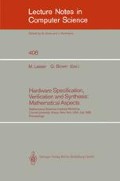Abstract
Many large scale circuits and systems contain a mixture of synchronous and asynchronous (self-timed) subsystems; examples include digital control units and sequencers, processing units that have asynchronous interfaces to busses or memories, and systems that contain modules that are clocked by independent, locally generated clocks. This paper addresses some of the formal issues that arise in the specification and synthesis of such “mixed-mode” systems. In particular, we outline a specification technique suitable for such systems, formalize the notion of timing disciplines in this context, and indicated how the introduction of timing disciplines into a design affect the associated specifications. We also outline the correlations between the semantic models underlying such specifications, called temporally annotated labeled event structures (abbreviated TALES) and timing diagrams that are commonly used for specifying some of the temporal characteristics of interfaces. Some experiments in prototyping some of the implementation strategies for asynchronous, self-timed and mixed-mode systems are summarized.
Preview
Unable to display preview. Download preview PDF.
References
T. S. Balraj and M. J. Foster. Miss Manners: A specialized silicon compiler for synchronizers. In Proc. 1986 MIT Conference on Advanced Research in VLSI, pages 3–20, MIT Press, 1986.
Brayton R. K. et al. The Yorktown Silicon Compiler. In Silicon Compilation, D. Gajski ed., pp. 204–311, Addison-Wesley, Reading, Mass., 1988.
L. Cardelli and P. Wegner. On understanding types, data abstraction, and polymorphism. ACM Computing Surveys, 17(4):471–522, December 1985.
T. J. Chaney and C. E. Molnar. Anomalous behavior of synchronizer and arbiter circuits. IEEE Transaction on Computers, 5C-22(4):421–422, April 1973.
T.A. Chu. Synthesis of self-timed control circuits from graphs: an example. In Proc. ICCD 1986, pages 565–571, IEEE Press, 1986.
R. A. Newton and B. Preas. 25 Years of Electronic Design Automation. Association for Computing Machinery, 1988.
Alan L. Davis. Generation of completion signals used in the design of the FAIM-II machine, personal communication. 1988.
J. A. Goguen. Parameterized programming. IEEE Trans. on Software Engg., SE-10:528–552, September 1984.
C. A. R. Hoare. Communicating Sequential Processes. Prentice-Hall International Series in Computer Science, 1985.
Hollaar, L. A. Direct Implementation of Asynchronous Control Units. In IEEE Transactions on Computers, pages 1133–1141, C-31(12), December 1982.
David Horn. A 32-bit Implementation of the S/NET Multiprocessor System. Technical Report, AT&T Bell Laboratories, September 1986.
IEEE. IEEE Standard for a Versatile Backplane Bus: VMEBus. IEEE Press, 1988.
T. H.-Y. Meng et al. Asynchronous processor design for digital signal processing. In Proc. IEEE ICASSP, April 1988.
A. Martin. The design of a self-timed circuit for distributed mutual exclusion. In Proc. 1985 Chapel Hill Conference on VLSI, Computer Science Press, 1985.
R. Milner. A Calculus of Communicating Systems. Springer Verlag, LNCS 92, 1980.
B. Moszkowski. A Temporal Logic for Multilevel Reasoning about Hardware. In IEEE Computer, Feb 1985, pp. 10–21.
C. L. Seitz. Self-timed VLSI Systems. In Proc. Caltech Conference on VLSI, 1979.
P. A. Subrahmanyam. Synthesizing VLSI circuits from behavioral specifications: a very high level silicon compiler and its theoretical basis. In F. Anceau, editor, VLSI 83: VLSI Design of Digital Systems, pages 195–210, North Holland, August 1983.
P. A. Subrahmanyam. Automated Synthesis of Systems with Interating Asynchronous (Self-timed) and Synchronous Components. Proceedings of ICCD 89, IEEE Press, October 1989.
T. E. M. Horowitz R. L. Alverson Williams and T. S. Yang. A self-timed chip for division. In Advanced Research in VLSI, Proc. of 1987 Stanford Conference, pages 75–96, MIT Press, March 1987.
G. Winskel. Events in Computation PhD Thesis, Edinburgh University 1980.
Author information
Authors and Affiliations
Editor information
Rights and permissions
Copyright information
© 1990 Springer-Verlag Berlin Heidelberg
About this paper
Cite this paper
Subrahmanyam, P.A. (1990). What's in a timing discipline? Considerations in the specification and synthesis of systems with interacting asynchronous and synchronous components. In: Leeser, M., Brown, G. (eds) Hardware Specification, Verification and Synthesis: Mathematical Aspects. Lecture Notes in Computer Science, vol 408. Springer, New York, NY. https://doi.org/10.1007/0-387-97226-9_30
Download citation
DOI: https://doi.org/10.1007/0-387-97226-9_30
Published:
Publisher Name: Springer, New York, NY
Print ISBN: 978-0-387-97226-8
Online ISBN: 978-0-387-34801-8
eBook Packages: Springer Book Archive

